
The Danube-Black Sea clean-up story
What’s needed to reduce pollution in the most international river basin in the world and the Black Sea into which it empties? Working in farms, wetlands, wastewater treatment plants, schools, boats and office boardrooms, the UNDP/GEF Danube Regional Project, ending soon, had many of the best answers.
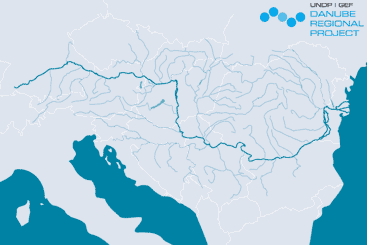
 Nutrient pollution
is a serious problem throughout the Danube River Basin and can put areas at risk of not meeting the objectives of the EU Water Framework Directive.
Nutrient pollution
is a serious problem throughout the Danube River Basin and can put areas at risk of not meeting the objectives of the EU Water Framework Directive.We Danube lovers begin our tour in the village of Neuzin in the county of Vojvodina, north Serbia. The familyrun farm managed by Dragan Dzenopoljac raised 40 cows for milk production. They had a problem. Their cows produced a lot of manure that they couldn’t store properly. The manure ended up as a large unsightly pile on one of the farm’s fields. Yellow liquid literally floated away.
Many of the surrounding farms, run by families or large companies, had the same problem. They typically raised livestock such as pigs, cows and chickens, and produced crops such as maize, sunflower and barley. One Vojvodina factory in the village of Zitiste employed 3000 people and daily slaughtered 30,000 chickens (12 million yearly).
The result was an agricultural landscape dotted with large mounds leaching pollution. Some farmers used water hoses to flush manure out from their livestock sheds – a particularly ‘bad agricultural practice’ which makes manure management difficult and costly. Around Zitiste and neighbouring villages, a lot of manure was entering the local Begej River, the Danube–Tisza–Danube Canal and eventually the Danube River itself. Everyone from residents to mayors was gravely concerned.
BAPs to the rescue. Besides its awful sight and odour, manure in water causes another problem that is far less known – nutrient pollution. Manure contains nutrients, especially nitrogen and phosphorus, which contribute to ‘eutrophication’. Through this process, oxygen in the water is reduced, plant and animal species suffocate and water quality worsens. A sure sign is large green, black or brown algal blooms. Certain types of bacteria can also develop making drinking water unsafe. So nutrients are not always ‘nutritious’.
The Vojvodina farms had other ‘bad practices’ that contributed to nutrient pollution. One was the poor application of nitrogen-based fertilisers on crops – for example, spreading too much or at the wrong time of year.
In 2006, the Dzenopoljacs were approached by the company Carl Bro requesting that their farm serve as a demonstration site for a larger project. Soon they agreed to the building of a facility which would store about 180 m 3 of manure for six months. Carl Bro would supervise construction while Dragan would pay 10% of the costs.
The Dzenopoljac’s farm was one of eight that Carl Bro eventually worked with in the area. And building the manure storage was one of 15 ‘best agricultural practices’ (BAPs) that Carl Bro trained the farmers in using. Others included the preparation of fertiliser plans and spreading manure fertiliser on fields between 15 October and 1 March. Some of the BAPs also reduce toxic pollution.
In the end, the project found that implementation of the 15 BAPs by the eight farms could annually save the environment from about 14,000 kg of nitrogen, 2000 kg of phosphorus and 250 kg of pesticides.
The Carl Bro project was funded by the Danube RegionalProject (DRP), begun in 2001, recently ending in June 2007, managed by the UNDP and funded by the Washington D.C.-based Global Environmental Facility (GEF). Managed from the Danube city of Vienna, the DRP’s main goal was to reduce nutrient and toxic pollution to Danube Basin waters. Its main beneficiaries were the 13 Danubian countries that signed the Danube River Protection Convention and are cooperating under the ICPDR.
CLEANING THE PRUT
About 650 km to the northeast of
Vojvodina is the Falesti District of
Moldova. Here, the NGO Cutezatorul
of Falesti was also working to reduce nutrient and toxic runoff
from farms. Pollution entered the Prut River
which then entered the Danube River. The NGO’s
DRP-supported initiative involved nine NGOs, 90
farmers, national and international experts and local governments. Organisers established four
chemical-free demonstration gardens and their ‘green phone hotline’ advised 138 callers about
earth-friendly farming.
Community-wide efforts included brochures, 16 radio broadcasts and four TV programmes about organic farming. Action campaigns encouraged residents to clean up pollution hotspots. A contest to identify the cleanest, greenest area of the Prut River Basin drew the participation of 24 municipalities and resulted in the removal of 15 illegal dumps, the planting of 17,000 trees and the tidying up of 12 springs. The NGO even successfully convinced 70% of the farmers that they trained to use fewer chemical fertilisers and herbicides on their farms.
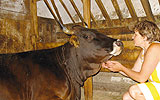 One source of pollution is
the over-production and
poor handling of solid
manure and liquid waste
from raising livestock.
One source of pollution is
the over-production and
poor handling of solid
manure and liquid waste
from raising livestock.From my farm to three countries. Some 600 km to the east of Vojvodina is the village of Maluk Preslavez, next to the Danube, in the Silistra area of Bulgaria’s Dobrudzha region. In July 2005, testing from a spring found groundwater to be three times over the national limit for nitrates, a type of nutrient. “We didn’t think it was that bad,” says local farmer Ancho Angelov. “We stopped using the fountain years ago but didn’t realise there was still such a problem and that the pollution was coming from our cows.”
The spring was close to a demonstration farm field that had been divided in two. On one side, good agricultural practices had been used to apply nitrogen and phosphorus fertilisers to the soil. On the other, bad practices common to the area were used. The experiment was part of the Eco-accent: Plant Growing in Dobrudzha project managed by the Black Sea NGO Network and funded by the DRP. “We chose this region because it’s the most productive farming area in all of Bulgaria,” says project manager Emma Gileva.
Some 120 local farmers visited the demonstration sites and participated in trainings. It was their first chance to hear about the country’s new Code of Good Agricultural Practice. Adopted in August 2005, the Code was the result of Bulgaria harmonising the EU Nitrates Directive, a pre-condition to its later entering the EU in January 2007. “They also learned that the entire Danubian part of Bulgaria is a ‘vulnerable area’ according to Bulgarian and EU legislation, meaning that it is threatened by nitrate pollution,” says Gileva.
A few months later, the same field in Maluk Preslavez had some new visitors. Fifteen farmers from Romania and three from Moldova came to see the benefits of soil conservation, water protection and ‘best agricultural practices (BAPs)’. For 11 Romanian farmers, it was the first time they had travelled outside their country. “For the farmers from Moldova, the BAP concept was almost completely new,” says Gileva.
The international visit was part of the larger DRPfunded ‘Best agricultural practice’ in my farm project implemented by the Black Sea NGO Network with NGO partners Earth Friends from Romania and the Eco Counselling Center Cahul from Moldova. The goal was to get farmers more involved in BAPs through visits, trainings and published materials in six rural municipalities in three countries. Farmers learned about how to receive support payments or to be involved in agri-environment schemes if their practices exceeded minimum BAP standards. 500 copies of a new BAP booklet were also distributed in each country.
Two trainings were held for farmers in each country, bringing in 221 farmers total – 40% more then expected. In Bulgaria, BAPs were newly applied onto 70,000 ha of farmland, 94 ha were converted to organic farming and 120 farmers improved their chemical use reporting.
In Romania, where the information was relatively new, some 80 small farmers, most with lands under 4 ha in area, became more aware about and encouraged to use BAP. In the village of Brusturoasa, two farmers built new manure composts based on BAP standards. And in the village of Piscu, two farmers who participated in the training later wrote proposals with their local Agricultural Advisory Service to improve the chemical management of their cereal crop cultivation – and successfully received grants through the EU. “Farmers and advisory services became more aware of the need to comply with the Romanian Code of Good Agricultural Practice to access EU funds for farms,” says Camelia Zamfir from Earth Friends. “We are confident that more farmers will change their practices.”
The project also worked on getting farmers and others more involved in using ‘voluntary charters’. One charter, signed by 24 Bulgarian farmers, had them declare that “every farmer can do simple things to protect the environment and water. Let us not turn farming into a mechanism of pollution that ruins nature and our future.” The charter then presented obligations to protect the environment such as checking soil conditions before using fertilisers. “Every time I go to the fields, I will try to observe the state of nature and decide how my farming activities have affected it.”
NUTRIENTS, LAWS AND RISKS
By 2004, Danube countries had successfully met
the first step of the WFD process – producing the
Danube River Basin Analysis. By 2009, informed by
this Analysis, they need to develop a ‘joint programme
of measures’ as part of a ‘Danube River Basin
Management Plan’ to ensure that all Danube waters
meet ‘good ecological status’ requirements by
2015. The WFD also requires the complete phaseout
of the EU’s 33 priority hazardous substances
within 20 years.
The Danube Analysis further included an assessment of whether Danube water bodies risked failing to meet the WFD. This was done in relation to four ‘risk categories’, two of which were nutrients and hazardous substances. It found 55% of the entire basin ‘at risk’ or ‘possibly at risk’ from nutrient pollution and 73% from hazardous substances.
The Nitrates Directive is another important EU tool, designed to protect EU waters against nitrate pollution from agriculture, especially those caused by bad practices such as poor manure storage. If areas have pollution levels that are or could be high, states must designate them as ‘nitrate vulnerable zones’ and apply agricultural ‘action programme measures’, as is the case for Danubian Bulgaria. Every country also needs to make its own Code of Good Agricultural Practices (similar to BAPs) harmonised with this directive, and is encouraged to apply them to reduce nitrate levels.
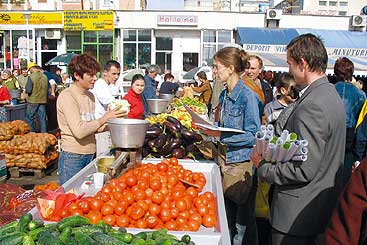
The end of communism meant competition with powerful western agro-companies and their cheaper products.
AGRICULTURE – A DECADES-OLD PROBLEM
According to the Danube River Basin Analysis 2004,
agriculture is now the biggest source of nitrogen
in the Danube Basin with a 39% share. It is also the
second biggest source for phosphorus emissions in
the basin with a 32% share.
The Danube Analysis found “alarming concentrations”
of pesticides in the lower Danube and in some tributaries. The Danube Basin is home
to 29 of the EU’s list of 33 ‘hazardous priority
substances’. Many are used in producing cereals,
rapeseed, sunflower, maize, orchard fruits and grapes. A shocking seven are not authorised in any
country. The Analysis also found Danube groundwater
at a high risk of pollution from agricultural
fertilisers and chemicals. That’s a big problem because,
overall, 48 million people in the basin depend
on groundwater sources for drinking water.
“The problem accumulated over many decades,” says DRP Environmental Specialist Peter Whalley. “During communism, environmental management wasn’t properly considered by the large state farms. Back then, a ‘good farm’ was a big farm with lots of livestock, and where lots of fertilisers and pesticides were used to boost production.”
After communism ended, many farms were hard hit by lost markets, downsizing or even outright bankruptcy. Pesticide use declined by 40% and livestock numbers dropped 50%. But now that many economies are reviving in post-communist Europe, livestock and manure numbers could rise. That could mean more pollution, especially because environmental management is still low on the priority lists of most farmers.
“We see the same problem in many places in the region,” says Whalley. “Many small farmers are new to farming, having lost their jobs in other sectors that collapsed. Or they lack the required information, education and training support needed to farm wisely, or the resources to begin the process of investing in cost- and environment-saving measures. It’s easy for them to fall into the short-term fertiliser- pesticide trap.”
 Many farmers aren’t aware
of the environmental
problems they cause, let alone how to solve them.
Many farmers aren’t aware
of the environmental
problems they cause, let alone how to solve them.More farmers, less nutrients. Through a Small Grants Programme run by the DRP, 53 NGO-managed projects focusing on agriculture across 11 countries in the Danube Basin were funded. From Vojvodina to Silistra to Moldova and beyond, the DRP successfully assisted NGOs in raising the awareness of residents, farmers, the media and authorities about agricultural pollution and EU water protection directives. Hundreds if not thousands of farmers were trained in how to apply BAPs. Many made the switch. More are on their way.
The Carl Bro project also delivered. “If the final results from the Vojvodina sites were extended to farmers throughout the Lower Danube River Basin, especially in Bosnia and Herzegovina, Bulgaria, Croatia, Moldova, Montenegro, Romania, Serbia and Ukraine, then the introduction of the 12 BAPs dealing with livestock manure management would save the environment over 500,000 tonnes of nitrogen and 90,000 tonnes of phosphorus annually,” says Carl Bro Project Manager Jesper Ansbaeck “Given the expected increases in livestock production in the next few years, this could increase to 1.1 million tonnes of nitrogen and 160,000 tonnes of phosphorus.”
The environment and food chain in all seven countries could also be saved from 23,000 tonnes of pesticides under current consumption and 50,000 tonnes under expected future conditions. Farmers would further benefit economically from BAPs through reduced expenditures on fertilisers and pesticides, more cost-effective farming practices and improved product quality.
ENTER THE BLACK SEA
The Danube Analysis also found the
Black Sea’s coastal waters, into
which the Danube River flows, ‘at
risk’ from nutrient pollution and
‘possibly at risk’ from hazardous
substances. With over half of the Sea’s waters originating
from the Danube, the Danube’s waters are
bound to have considerable impact. To many, this
was no big surprise given decades-long awareness
that the Black Sea was in jeopardy.
In the 1970s and 1980s, excessive nutrient pollution led to a severe ecological imbalance in, and the large-scale eutrophication of tens of thousands of square kilometres of, waters in the western Black Sea, as the depletion of oxygen decreased biodiversity and worsened water quality. This was actually one of the main reasons why the GEF became involved in Danube and Black Sea efforts in the first place. In 1992, the Danube Basin was site of the first ‘international waters regional programme’ ever funded by the GEF. By 2001, GEF activities had evolved to become the DRP.
The DRP is part of the larger USD 95 million ‘GEF Strategic Partnership for Nutrient Reduction in the Danube/Black Sea Basin’ approved in 2001. It targets assistance in Danube and Black Sea countries to address transboundary concerns from nutrient pollution. One of GEF‘s largest and perhaps most ambitious water-related projects in the world, its long-term objective is for countries to take measures to reduce nutrient pollution and hazardous substances to levels necessary to permit Black Sea ecosystems to recover to 1960s conditions.
The Partnership includes three components. The first is the DRP. The second is the ‘Black Sea Ecosystem Recovery Regional Project’ for the six Black Sea littoral countries. The third is the ‘Investment Fund for Nutrient Reduction’ implemented by the World Bank, geared to supporting single-country investment projects for nutrient reduction as well as wetland and floodplain restoration.
One of the key achievements of the DRP was to strengthen cooperation between Danube and Black Sea decision-makers, for example through producing the first report on the impacts of the Danube on the Black Sea.
 On many farms, nearly half of all livestock waste becomes pollution.
On many farms, nearly half of all livestock waste becomes pollution.No time to waste for wastewater. Polluted wastewater discharged by Vienna to the Danube is minimal. That’s generally the case in the Upper Danube countries of Germany and Austria, in part because they were able to pay for the high costs of advanced wastewater treatment. By doing so, they also met the EU Urban Wastewater Treatment Directive (UWWT), designed to protect the environment from the adverse effects of wastewater from cities and the agro-food industry. In the countries downstream, however, wastewater treatment was often neglected during communism. As a result, the messy municipal brews of residential and industrial waste are another major source of Danube nutrient pollution. “The UWWT is expected to be the most expensive EU water quality requirement to implement for the new Member States,” says ICPDR Technical Expert Mihaela Popovici. “In Romania, it could account for over 45% of the total costs for complying with EU environmental regulations.” One UWWT requirement is that wastewater treatment should be ‘more stringent’ in ‘sensitive areas’ where water bodies are eutrophic. That could mean introducing ‘tertiary treatment’ to remove nutrients. And loans and grants to improve treatment are available through the EU and international financing institutions such as the World Bank and EBRD.
TREATMENT WITHOUT ELECTRICITY IN RURAL SLOVAKIA
At a small settlement of houses
near the Hnilec River, 75 km outside
Kosice, Slovakia, residents found
it hard to get external funding
to clean their wastewater. “Our
system filled the gap,” says Robert Zvara, project
manager of the NGO Creative. “It’s inexpensive,
environmentally friendly and low maintenance, so
it’s helpful for distant communities in Slovakia
and throughout the Danube Basin.” The DRP-supported
system sends household sewage through
pipes funded by the local municipality to improved
settling tanks and a newly constructed reedbed
that removes nutrients – without using electricity.
“The quality of output water released to the creek
doubles national standards and helps maintain the
quality of the nearby protected EU Natura 2000
meadow lands.”
CLEAN CLOTHING, DIRTY RIVER
Many residents of cities in the central and lower
Danube Basin use cleaning detergents with phosphates
– another big contribution to nutrient pollution. At the same time, alternatives are already
widely used by many consumers, companies and
countries in the Danube Basin and beyond. In some
Danube countries such as Austria, Germany and the
Czech Republic, complete or near complete switches
have already been made.
A DRP-commissioned project found that the Danube countries most requiring reductions in phosphate-based detergents are Bosnia and Herzegovina, Bulgaria, Croatia, Hungary, Moldova, Montenegro, Romania, Serbia, Slovakia and Ukraine, representing about three quarters of the basin population. Romania was seen as a priority given its lack of wastewater treatment infrastructure and gains to be made through Black Sea tourism.
While improved urban wastewater treatment and BAPs are necessary complementary actions, the project clearly showed that there is ample scope for contributing to solving eutrophication by switching to phosphate-free detergents. The main adverse effect is expected to be on the phosphate industry, not on the detergent industry. Nonetheless, large multinational detergent manufacturers were not convinced. The study thus found that EU legislation to ban or reduce phosphates in detergents would be more effective in dealing with the problem than voluntary agreements with producers.
In Sarajevo, Bosnia and Herzegovina, a DRP-funded project by the NGO Ekotim, raised awareness among consumers about the links between their detergent use and water pollution from phosphates. Communication activities proved highly successful, reaching some 200,000 Sarajevo citizens.
Over 20,000 leaflets were distributed in a wide range of places from shopping centres to street actions to bars. A radio jingle was played 10 times a day for 11 months, along with 20 radio shows, reaching the ears of over 150,000 people. Other actions included the distribution of 9000 postcards throughout the city, workshops in schools, advertising billboards placed in public toilets and stories in national newspapers.
Post-campaign testing of city wastewater proved that the campaign reduced total phosphorus discharge to the river from 310 to 245 kg per day. “The phosphate detergent industry, mainly Proctor & Gamble and a detergent factory from Croatia, opposed us with their own TV commercials,” said Rijad Tikvesa from Ekotim. “But the Bosnian company ‘Dita’ from Tuzla ended up developing a new line of phosphate-free detergents. So we think we’ve had a very positive effect.”
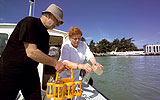 Municipal wastewater
can cause excessive
organic pollution, a key
issue identified by the
ICPDR’s ‚Danube River
Basin Analysis’.
Municipal wastewater
can cause excessive
organic pollution, a key
issue identified by the
ICPDR’s ‚Danube River
Basin Analysis’.Paying the price for clean water. The 60,000 residents of Karlovac, Croatia, had never been happy about their untreated wastewater entering the local Mrežnica and Kupa rivers. They never liked how it affected the city’s drinking water or local swimming, fishing and boating. With Croatia in the process of joining the EU, the city is also expected to be declared a ‘vulnerable area’ under the Nitrates Directive.
“This is why Karlovac agreed to build a new wastewater treatment plant with tertiary treatment – the first time in this country,” says Kresimir Veble, a manager at Karlovac’s water supply and wastewater treatment utility. “And the sewer network will be extended to more households.”
To pay for the investments, the utility received a total of EUR 36 million in grants and loans from the EC, EBRD and Government of Croatia. Now it has to determine how to best spend the money, how to cover its own operating costs and what price to charge customers. Not long ago, those decisions were made by the state. Now it’s the responsibility of Kresimir and his colleagues who, while good engineers, were never really trained in finance.
“The first step is for utility managers to take an honest look at their true current costs and where they might be losing money now,” says András Kis, a Budapestbased consultant working on the DRP sub-project. “Reforms such as reducing leakage from old pipes free up money for new investments.”
Seeing that people like Kresimir and his colleagues lacked the necessary financial tools to assess these complex considerations, Karlovac was selected as a demonstration site for the DRP project. Pitesti in Romania was another. “Once Karlovac selects its reforms, then these can be fed into our new decision-making tool called ASTEC,” says Kis. “This will then give a range of various prices they can charge consumers for future services.” ASTEC tests the impacts of a range of simultaneous considerations on pricing. “With ASTEC, we discovered that many customers weren’t paying their bills including 20% of the utility’s own employees – a problem we fixed in one week,” says Veble.
THE NEED IS THERE
One lesson learned was the clear need for help, and
that the tools are available. Fact sheets, translated
and distributed to hundreds of targeted utility
managers in 10 countries, were complimented by
workshops where feasible. A presentation to the
Romanian Water Association’s utility managers
also attracted lots of interest. “But the process
needs to continue to guide the right people to use
the tools,” says Kis. Experience showed that small
investments in training bring positive benefits. Building
on the foundations laid by DRP, the process
should now be “nationalised” with support from
governments, the ICPDR and external donors.
“Donors want informed customers,” says the World Bank’s Ron Hoffer. “We’d love to give countries more support for soft services like training. But countries need to ask for it.”
Furthermore, many utility managers don’t see pollution reduction as their main priority, says UNDP/ GEF Danube/Black Sea Regional Programme Director Ivan Zavadsky. “Many are just trying to prevent bankruptcy. But these tools can still help them do that. And having been trained to use them, they’ll be much better prepared to make investment decisions for improving pollution reduction later on.”
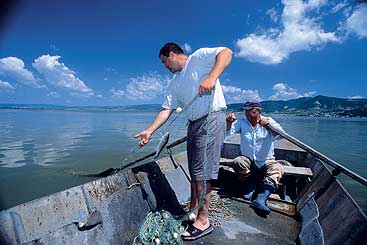
Over the last 150 years, Danube aquatic ecosystems, biodiversity and water quality and quantity have been significantly impacted by human activities.
Turning farmland into nutrientremoving hay. Some 400 km northeast of Karlovac is the Zitava Valley, part of Slovakia’s Vah River Basin. The Vah enters the Danube about 100 km east of Bratislava. In the Zitava, some 80 ha of wet grasslands in a Natura 2000-rated area were subject to annual spring floods, making it unattractive for farming. At the same time, soil erosion in the surrounding arable fields was a major problem for the local Vah River management agency.
In 2005, the NGO SOS/BirdLife Slovakia implemented a DRP-funded project to apply BAPs to control agricultural pollution. As one result, farmers converted and restored 15 ha of regularly flooded arable soil into grassland through two steps. One, seeds collected from intact meadows were dispersed onto the soil. Two, small cut pieces of intact grassland were transferred to the restoration area. The new grass was then periodically mowed to prevent it being overgrown with forest. As a result, the mowed grass served as a natural nutrient ‘sink’, retaining some 3.9 tonnes of nitrogen from the Zitava River yearly.
A second action restored wetland habitat in the adjacent Zitavsky luh, a Special Protection Area under the EU Habitats Directive. Here, 10 ha of grassland will now be cut yearly to renew plant communities and improve habitat for wetland birds. “This helped me to clean up my overgrown wet meadows and increase the hay that I can mow,” said František Varsanyi, a participating farmer. The harvested hay will then be sold to local farmers, including the nutrients retained – about 15 tonnes of nitrogen yearly.
Actions were communicated via the media, schools and meetings with municipal authorities and farmers. 5000 information leaflets were also distributed. “This project really helped us to present the countryside around our village as one of the last places where the Zitava River still creates valuable wetlands,” says Ludovit Sládecˇek, mayor of Kmet’ovo village.

A DRP study shows that wetlands can definitely retain nutrients and help reduce nutrient pollution.
Taking wetlands more seriously. Going some 150 km back to Vienna, another DRP project completed a review of scientific literature that found that wetlands definitely can retain nutrients and thereby can help reduce nutrient pollution. Through an analysis of current and past wetlands projects in the basin, it also found a serious gap – wetland and river basin managers tend to find little importance in using wetlands for nutrient removal, if for anything at all. “I learned as an engineer that we should drain the marshes,” says Gheorghe Constantin, Head of the Romanian Delegation to the ICPDR, adding that DRP efforts helped him to realise the multiple beneficial functions of wetlands.
Where wetland projects do exist, they focus on local biodiversity conservation. Some projects also use wetlands to help with flood mitigation, and this trend is growing. Overall, however, wetland work tends to be isolated to the local level without connections to wider regional or river basin management (RBM) efforts.
Some 60 km next door in Slovakia, the Vienna findings were confirmed through a DRP-funded project managed by the NGO Daphne. Early on, Daphne found that most Slovak managers saw their main goals as ensuring good water quality and quantity, protecting property and making water resources available for industrial water users. “This is important but it’s not enough,” says Daphne’s Milan Janak. “Managers need to pay more attention to wetlands and their responsibility to protect them.”
Some Slovak managers are restoring wetlands. For example, in the Morava floodplains, a project helped recharge an old disconnected wetland with water, restoring habitat for birds and beavers. “This is a good start,” says Janak. “But now we want more wetland projects to help solve other problems like floods and soil erosion.”
In workshops held across the country for about 150 water managers, Daphne raised awareness of the importance of restoring wetlands and floodplains. “There has been an increasing realisation that managers need more guidance and push,” says Thomas Hein, manager of a DRP wetlands project. “For that reason, the DRP developed a ‘guidance document’ that helps define why and how managers can beneficially incorporate wetlands into their routine RBM efforts, and how to monitor them. We hope that the ICPDR and NGOs take a lead in making sure the document gets used.” issues.
THE DEF AND WETLANDS
Some 280 km southeast of Vienna
is Baja, Hungary – home to some of
the Danube Basin’s most fantastic
and protected floodplain forests
and species, and the Danube Environmental
Forum (DEF). “Wetlands work is one of
the cornerstones of our activities so we will continue
to encourage Danube managers to take wetlands
more seriously and to use the DRP’s guidance
document,” says the DEF’s Johannes Wolf.
The DEF is an umbrella organisation of NGOs in the Danube River Basin. Today, it has 174 member organisations from 13 Danube countries, thanks in large part to UNDP/GEF support over the last 10 years. DRP helped DEF to strengthen its network, establish a Regional Secretariat to coordinate its multi-country activities and to raise the capacities of its members to resolve Danube pollution
Many DEF NGO members, such as Daphne in Slovakia, contributed to DRP wetland protection and pollution reduction efforts through DRP support.
On Croatia’s Drava River, an NGO created a longterm process for stakeholder dialogue and sustainable development planning. In Serbia, the DEF NGO launched a local campaign to tackle problems in the wetlands-rich Zasavica Special Nature Reserve. And in Slovenia, a project increased public participation in protecting the Vrbje Pond near the Savinja River, a tributary of the Sava River and a proposed Natura 2000 site rich in biodiversity.
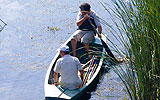 Wetlands are well known
for their importance as
habitats for water birds, as
well as their role in supporting
fish populations.
Wetlands are well known
for their importance as
habitats for water birds, as
well as their role in supporting
fish populations.Managing the basin. Reducing nutrient and toxic pollution from agriculture and municipal wastewater. Phasing out phosphate-based cleaning detergents. Encouraging managers to take wetlands more seriously. Building a basin-wide network of concerned NGOs.
Besides being DRP efforts geared to meeting the DRP’s own goals, they are also parts which can be fused together into a larger whole – namely, for integrated river basin management (IRBM) of the Danube Basin. IRBM has gained acceptance as essential for meeting the Danube River Protection Convention and EU Water Framework Directive (WFD). Looking at it this way, the DRP was therefore also able to signifi- cantly assist the Danube countries, ICPDR and the EU in meeting their own main goals.
DANUBE WATCH For the WFD, the key first step for the Danube Basin was the development of the Danube River Basin Analysis. Here, the DRP made significant contributions such as drafting chapters, facilitating country reporting, developing a new harmonised typology for rivers in the basin and preparing maps and translations. Most of the DRP’s efforts can also be incorporated into the Danube River Basin Management Plan being developed by the ICPDR and Danube countries for 2009. “Without the DRP, I doubt that we would have a Danube Analysis with such a high standard,” says Fritz Holzwarth, Head of the German Delegation to the ICPDR.
DRP efforts supported implementation of the WFD at the Danube ‘sub-basin’ level, especially for the Sava, Tisza and Prut river basins, under the umbrella of the ICPDR. For example, four national governments were assisted in reaching agreement on the structure of their first Sava River Basin Management Plan, related Road Map and steps for public participation developing under the coordination of the Sava River Basin Commission.
In the Danube Basin, technologies were continuously enhanced by the DRP to provide the best information possible for IRBM. This includes strengthening the Trans-National Monitoring Network through a design that meets the WFD’s strong requirements for monitoring water pollution loads. Support also went to sampling, with a research vessel, bottom sediment trapped behind Romania and Serbia’s ‘Iron Gates’ dam and testing it for pollution such as heavy metals.
In total, the DRP commissioned 177 contracts and held 69 workshops for over 1600 participants. Most likely, many thousands more Danube stakeholders were communicated to in one way or another through sub- and NGO projects. Additional support went to the ICPDR’s first Danube Stakeholder Workshop and International Danube Day, and the list goes on…
 Raising awareness and
encouraging public participation
in environmental
decisions have been key
features of IRBM.
Raising awareness and
encouraging public participation
in environmental
decisions have been key
features of IRBM.THE POWER OF STORIES
The story about how IRBM was built up in the Danube
Basin over 15 years was told by the DRP, with
ICPDR support, through its publication
‘15 Years of Managing the Danube
River Basin: 1991–2006’. It explains
how the efforts and cooperation of
UNDP/GEF, ICPDR, EU and the Danube
countries led to new programmes,
institutions and legal agreements,
as well as concrete environmental
progress. Lessons learned in applying
IRBM are also presented, as is the
Danube outlook for the next 15 years.
The DRP often depended on the power of stories to explain what it was trying to do and did. First there were the reports, fact sheets, photographs, website and this and other stories for Danube Watch. Countless other media told DRP stories – from magazines specialised in European water management at the international level to the thousands of leaflets, brochures, press releases and radio and TV broadcasts produced or targeted by nearly 100 NGOs working across the basin at the local level.
“We used communications to make targeted audiences more aware about problems and how to contribute to solutions,” says DRP Public Participation Manager Kari Eik. “Sometimes, we first strengthened the communications capacities of the people who we were encouraging to convince others, from managers of our sub-projects to NGOs.”
Another DRP project helped improve public access to water-related information and public participation in water management decision-making in five Danube countries. Outputs included reports, manuals for government employees, information databases, training, study tours, information dissemination and public participation tools and information brochures for citizens and NGOs.
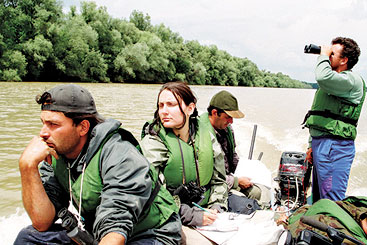
All eyes are on the Danube as water managers apply lessons to managing their own water bodies.
Fertiliser for the future. One sure sign of environmental progress is Black Sea recovery. “We are now witnessing the first reversal of a dead zone of oxygen depletion ever achieved on earth,” says the UNDP’s Andy Hudson. Earlier reductions in wastewater pollution from the upstream countries and the economic slowdown in the former communist countries were major contributors. But having cooperated in numerous joint efforts, the UNDP/GEF, ICPDR, EC and Danube countries should also take credit.
Danube countries are also on track in meeting their EU WFD requirements. This includes developing the Danube River Basin Management Plan by 2009, with the hope that by 2015, Danube waters meet WFD requirements including good ecological status.
“The DRP was an important fertiliser for our future work,” says Fritz Holzwarth. “It generated a common spirit to work together. But not everything is settled yet.” For example, national economic improvements could lead to increased fertiliser and pesticide use by farmers and thus more water pollution. “The ecosystem is still on a knife-edge and could revert back to its old problems,” says Marine Specialist Bill Parr.
“Making farmers more aware of BAPs will be a key measure in the Danube River Basin Management Plan, as will improving wastewater treatment and working to phase out phosphates in cleaning detergents,” says Philip Weller, Executive Secretary of the ICPDR. “We will therefore build on the important work already done by the DRP in these areas.”
The good news is that the ICPDR continues to be in an excellent position to take up the challenge. With contributions from UNDP/GEF and others, the ICPDR became a mature regional institution that is fully capable and skilled in guiding the Danube countries toward meeting their regional obligations through cooperative efforts.
The other good news is that UNDP/GEF will not totally disappear from the Danube with the end of the DRP. “Future GEF steps include continued support for the Tisza sub-basin and Dnieper Basin, the second largest contributor to the Black Sea after the Danube,” says Hudson. “We’ll also be actively replicating our experiences from the Danube globally to other river basins where we work. The world has much to learn from the Danube.”
For more information, please visit: www.undp-drp.org
The DRP‘s Small Grants Programme was the DRP‘s main vehicle for engaging local stakeholders.
Click here to see the DRP Small Grants Programme map.
Disclaimer
The information contained in the ICPDR website is intended to enhance public access to information about the ICPDR and the Danube River. The information is correct to the best of the knowledge of the ICPDR Secretariat. If errors are brought to our attention we will try to correct them.
The ICPDR, expert group members, nor other parties involved in preparation of information contained on this website cannot, however, be held responsible for the correctness and validity of the data and information provided, nor accept responsibility or liability for damages or losses arising directly or indirectly from the use of the information conveyed therein.
Only those documents clearly marked ICPDR documents reflect the position of the ICPDR.
Any links to other websites are provided for your convenience only. The ICPDR does not accept any responsibility for the accuracy, availability, or appropriateness to the user's purposes, of any information or services on any other website.
When using the information and material provided on this website, credit should be given to the ICPDR.
